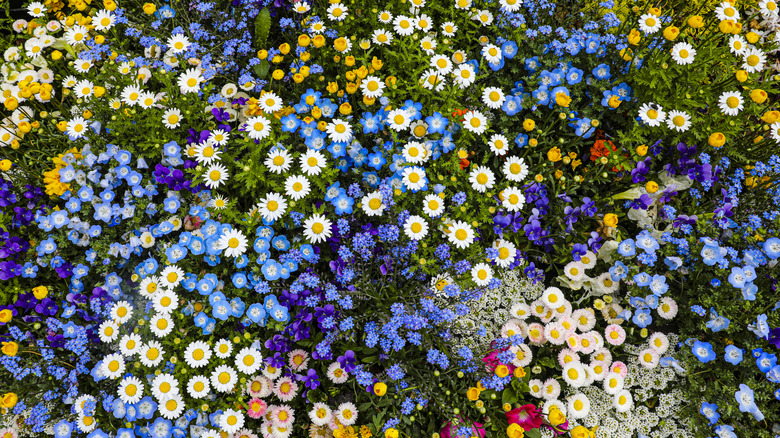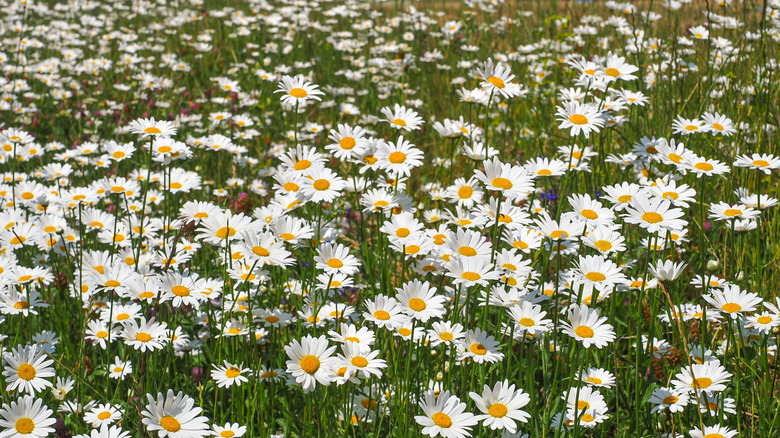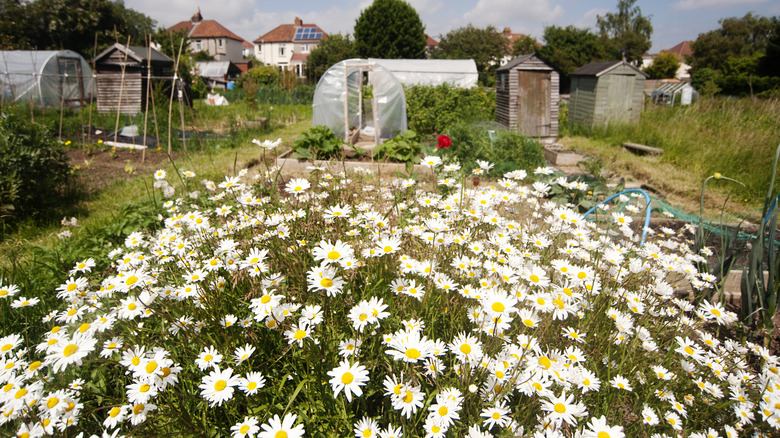Before You Plant Daisies, You Need To Know These Things
We may receive a commission on purchases made from links.
Believed to be around 50 million years old, it's probably safe to say that daisies have a lot of history behind them and ties to many cultures. Roman mythology tells of the nymph Belides turning into a daisy to escape the unwanted attention of the orchard god Vertumnus, while Christian traditions believe them to be representations of the Virgin Mary. From picking their petals to find out whether someone loves you (or loves you not) to being symbols of innocence, purity, and transformation, the flower has been a mainstay in gardens for centuries. And it makes sense why; they're easy to grow, hardy, and their crisp, white blooms can be a welcomed sight after getting through harsh winter doldrums.
But there's more than meets the eye with these flowers. Their cheery, innocent appearance can be a disguise for weedy, invasive growth habits that can develop into a real problem with certain daisy species. Understanding what you're getting into might make you think twice about propagating daisies. But, if you have your heart set on cultivating these mood-boosting blooms (maybe you're looking to design and plant the perfect cottage garden!), we also have some fail-safe tips and workarounds to make sure you don't land up with a problem on your hands. So, before you start sprinkling daisy seeds around your yard, here are all the things you need to know.
Many plants are called Daisies
One of the biggest problems starts with realizing that what one person thinks of as a daisy might not be the same as what's in your head. "Daisy" is sometimes used as shorthand for the admittedly much harder-to-say Asteraceae family, which is composed of over 23,600 species of plants, making it one of the largest flora families on Earth. While you might automatically toss out some members as obviously not being what someone might think of as a daisy, like endives or lettuce, things get a little murky for others.
For example, there's a classification of chrysanthemums called "daisy" that refers to a type of mum bloom, so some gardeners get understandably confused about which flower is which. Then there are the flowers with multiple common names, like Anthemis arvensis, known to some as Mayweed and others as Daisy, and both are technically right. But it gets even more mind-numbingly pedantic with ones we can all agree are actual "daisies" — Shasta daisies (Leucanthemum x superbum) are different from English daisies (Bellis perennis), and those are different from Gerbera daisies (Gerbera jamesonii), but they're all still understood to be a daisy. As you can probably tell, all of this can make it incredibly hard to get help if you're not well-versed in the nitty gritty of the species.
Some daisies are aggressive spreaders
Unfortunately, some of the most popular varieties of daisies are notoriously aggressive spreaders and can wreak havoc on your yard and neighboring plants that have to compete for resources. While this isn't a definitive list, there are a few varieties you need to know about before things get out of hand in your garden, namely Shasta, English, and oxeye daisies. Shasta daisies can go from a single plantlet to an overrun field faster than you think. English daisies are the same, easily escaping the confines of a garden and turning into a much-detested weed, but more on that later. Then there's the oxeye daisy (Leucanthemum vulgare), a prolific self-seeder that can drop up to 26,000 seeds per plant and is so invasive and aggressive that it's actually illegal to plant them in Wyoming.
But what's wrong with having a field full of pretty daisies? For one thing, they're hard to control and not everyone wants daisies making their way into lawns, vegetable patches, etc. On a larger scale, though, aggressive plants that push out native species affect food sources for many animals. Foraging animals like cows or deer don't find oxeye daisies particularly tasty, so they'll leave them alone while looking for other options. This lets oxeyes spread further, overtaking areas that were once where the preferred food source grew but are now open for oxeyes. When grazing animals release seeds from preferred food sources in their droppings, there's less space for these seeds to root and grow. That means fewer food resources for the animals, causing a ripple effect through the entire food chain.
Daisies can be damaging financially and health-wise
Let's take a step back and talk about the weedy aspect of daisies and the harm they can do to your little ecosystem, too. Imagine the money (and time) you'll waste when daisies crowd out other plants you've intentionally put in your garden or take over bare patches in lawns just laid with fresh grass seed. But it's not just about plant budgets; there are some health concerns to consider.
The sap from Oxeye daisies can cause contact dermatitis, while the English and showy daisies (Erigeron speciosus) have chemicals in their makeup that are mildly toxic to humans and pets. While this is not a definitive list, it gives you an idea of why adding an invasive plant to your garden can cause multiple problems that make it difficult to enjoy the fruits of your hard labor if you're constantly itchy, broke, and have to keep taking your dog to the vet.
Different daisies have different care requirements
Another reason the confusion over "Which daisy do you mean?" is so frustrating is that not all daisies flourish in the same growing conditions, wasting your effort and cash if you get their care requirements wrong. As an example, the perky yellow Angelita daisy (Hymenoxys acaulis) needs full sun in order to maximize its bloom potential. Meanwhile, the carpet daisy (Calyptocarpus vialis), which also has buttery-yellow blooms, thrives in shady spots where other plants are hard to grow. English daisies prefer consistently moist soil and won't tolerate drought well (especially showy ornamental varieties). While Gerber daisies also don't like their soil drying out too much, they don't like having water on their crowns (as they're adapted for bright African sunshine, not weeks of misty rain like English daisies), and overhead watering can trigger the onset of fungal disease.
Mistakenly planting one daisy in the wrong light or soil or fumbling its watering routine could mean your plant fails to thrive simply due to a misunderstanding around which species you really needed and why. To avoid this, once you find a particular type of daisy to plant, research its growing requirements specifically. If you already have some daisy-like plants and aren't sure what family they belong to, using a plant ID app or Google Lens might give you some useful clues.
There are daisy species that are less aggressive
Have we scared you off yet? If not, great, because there is good news if you're still a fan of daisies — not all species are considered aggressive. Hybridized daisy cultivars, native species, and certain varieties hailing from Australia, Africa, and Japan can be good substitutes. For instance, Shasta daisies can be a headache due to their prolific growth, but clever horticulturalists have found a way around that by creating subspecies that can be tamed thanks to the poor viability of their seeds or retooled growth patterns. These revamped Shastas have different names, with the "Becky" cultivar being a favorite and recommended by the Washington State Noxious Weed Control Board as a specific alternative to oxeyes.
Native daisies, like the Angelita, Arctic (Dendranthema arcticum), chocolate (Berlandiera lyrata), cutleaf (Erigeron compositus), and Easter (Townsendia exscapa) daisies are also excellent options because they're adapted to the specific growing conditions of certain native regions, often making them stronger and healthier than transplants. Also, native wildlife are drawn to them, which is great if you're interested in bringing more pollinators into your yard. Plus, there are naturally occurring controls that can keep them in check.
But if you want something a little exotic, the African (Dimorphotheca pluvialis), everlasting (Xerochrysum bracteatum), and Nippon/Montauk (Nipponanthemum nipponicum) daisies are all considered slow-growing and non-invasive. Just be sure to read up on the species-specific growing conditions to ensure they'll make it in your area. In particular, pay attention to their preferred pH level, soil composition, light, and moisture/humidity/water requirements.
How to deal with out-of-control daisies you've already planted
What if you're here because you've already planted an aggressive species of daisy and it's getting out of control; is there anything you can do? Thankfully, yes, but getting rid of daisies that have overtaken your yard will take some effort, and you might need to attack them multiple times. Weed control is broken down into five categories — biological, chemical, cultural, manual, and mechanical.
Biological control uses grazing animals to target weeds, but that gets tricky with daisies since some animals find them too bitter and will opt for something else. Chemical options are the least preferred due to their potential damage to the ecosystem, but there are a few home recipes that qualify as effective weed removal hacks, like clove oil, liquor, and dish soap. You can also try out horticultural-strength vinegar, such as the Green Gobbler 20% Vinegar Weed & Grass Killer.
Cultural control methods are proactive measures like ensuring your lawnmower wheels and blades are clean after use so they don't distribute daisy seeds, adding turfgrass to bulk up your lawn making it harder for daisies to take hold, or covering daisies with mulch or hay to block their light. Manual control involves dividing the plant to keep it in check, or digging it up entirely. For daisies that spread via rhizomes, like oxeyes, manually digging out all parts of the plant is probably the most effective method. Dividing a spreading plant is likely the best compromise for gardeners who want daisies but need to maintain some level of control. Finally, mechanical involves getting out the big guns and either mowing down daisies, repeatedly tilling the soil, or using flame weeding, which is the most nuclear-level option since it's effective but incredibly dangerous.
You should keep aggressive daisies in pots instead of growing them in flower beds
Besides regular dividing, there's another option that's a compromise if you really want "true" daisies — keeping them in containers. Restraining aggressive growers in pots is a clever way to keep invasive plants from spreading in your garden – just keep an eye on the drainage holes to prevent escapees. And most daisies do just as well as container plants as they would in the ground. But, as we've discussed, some species are prolific self-seeders, so even confining them to plant pot prison isn't a guarantee.
To reduce the chance of seeds spreading, you'll need to deadhead your potted daisy plant often. Snip spent daisies down to the next stem, leaf, or bud — whichever comes first. Not only will this make your plant look well-groomed, but cutting down to a node area encourages it to grow bushier instead of becoming leggy and sending stems out as scouts looking for a lawn to infest. Planting daisies in pots can also allow for easy overwintering. If you live in a northern state where English daisies grow as annuals, instead of letting them die down every year, bring your potted ornamental specimens indoors before the first cold snap.
These non-daisy alternatives can get you the same look without the headache
One of our preferred methods for living with daisies is to plant flowers that look like daisies but don't come along with the constant battle. The "daisy" shape is common across different families of flower plants, so there are a lot of species that can act as doubles for daisies, including feverfew, chamomile, and native options like white coneflowers.
Feverfew (Tanacetum parthenium) flowers are near knock-offs of English or Shasta daisies but with a stronger, more bitter smell. This herb produces long-lasting blooms, tolerates a touch of light shade, and can ward off annoying insects and help repel garden pests. Roman chamomile (Chamaemelum nobile) is another aromatic near-twin but is so problem-free that it's sometimes used in sensory or children's gardens.
Native options include the 'White Swan' coneflower cultivar (Echinacea purpurea 'White Swan') or the white woodland aster (Symphyotrichum lateriflorum), both of which are recommended alternatives to oxeyes. Garden cosmos (Cosmos bipinnatus) are also plants that look daisy-like especially if you get white-blooming flower varieties. However, while they are native to the Americas and not considered aggressive since they're annuals, cosmos plants can self-seed easily so you might want to keep an eye out and deadhead to prevent them popping up in locations you'd prefer not to have cosmos growing.








